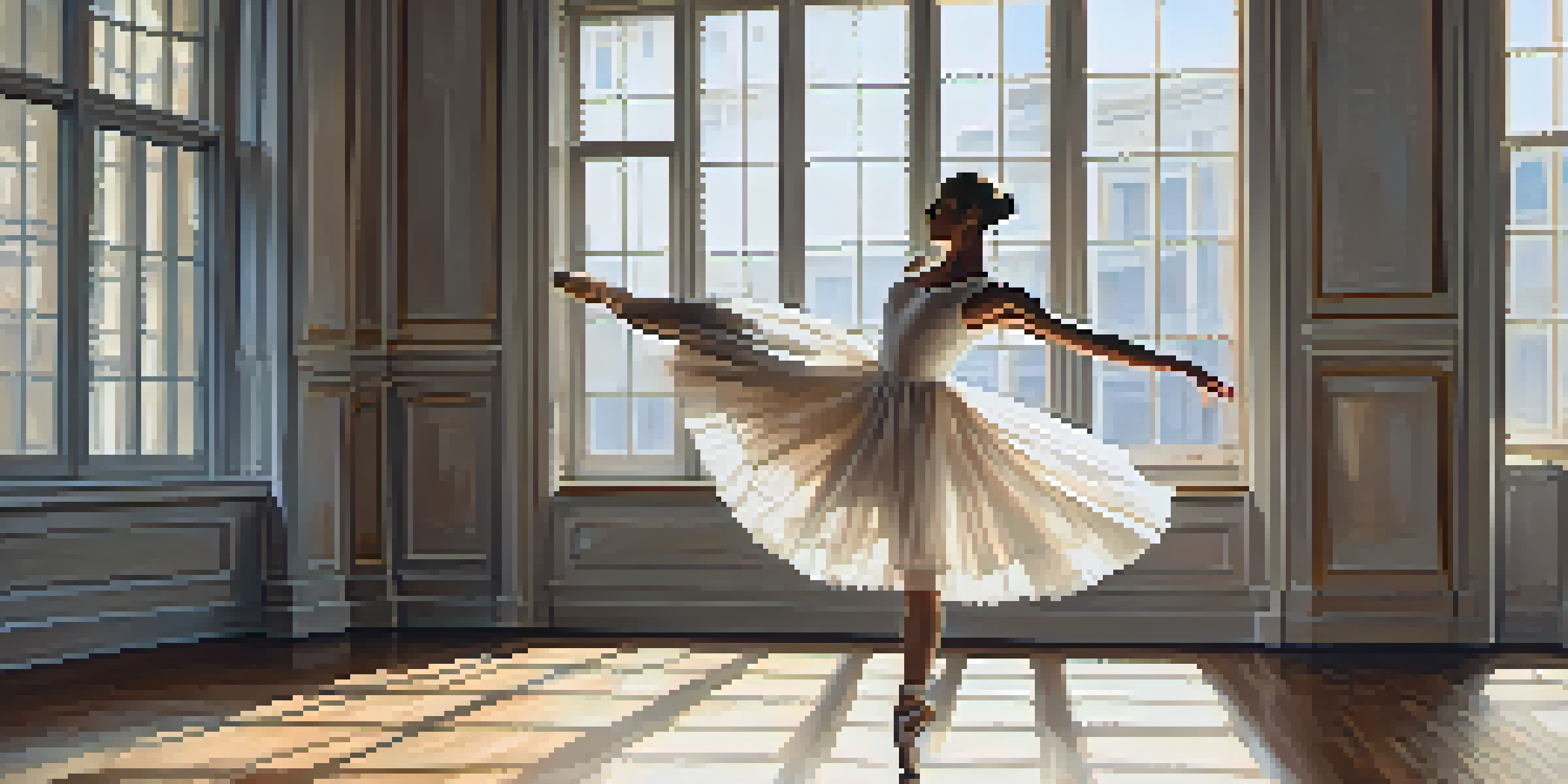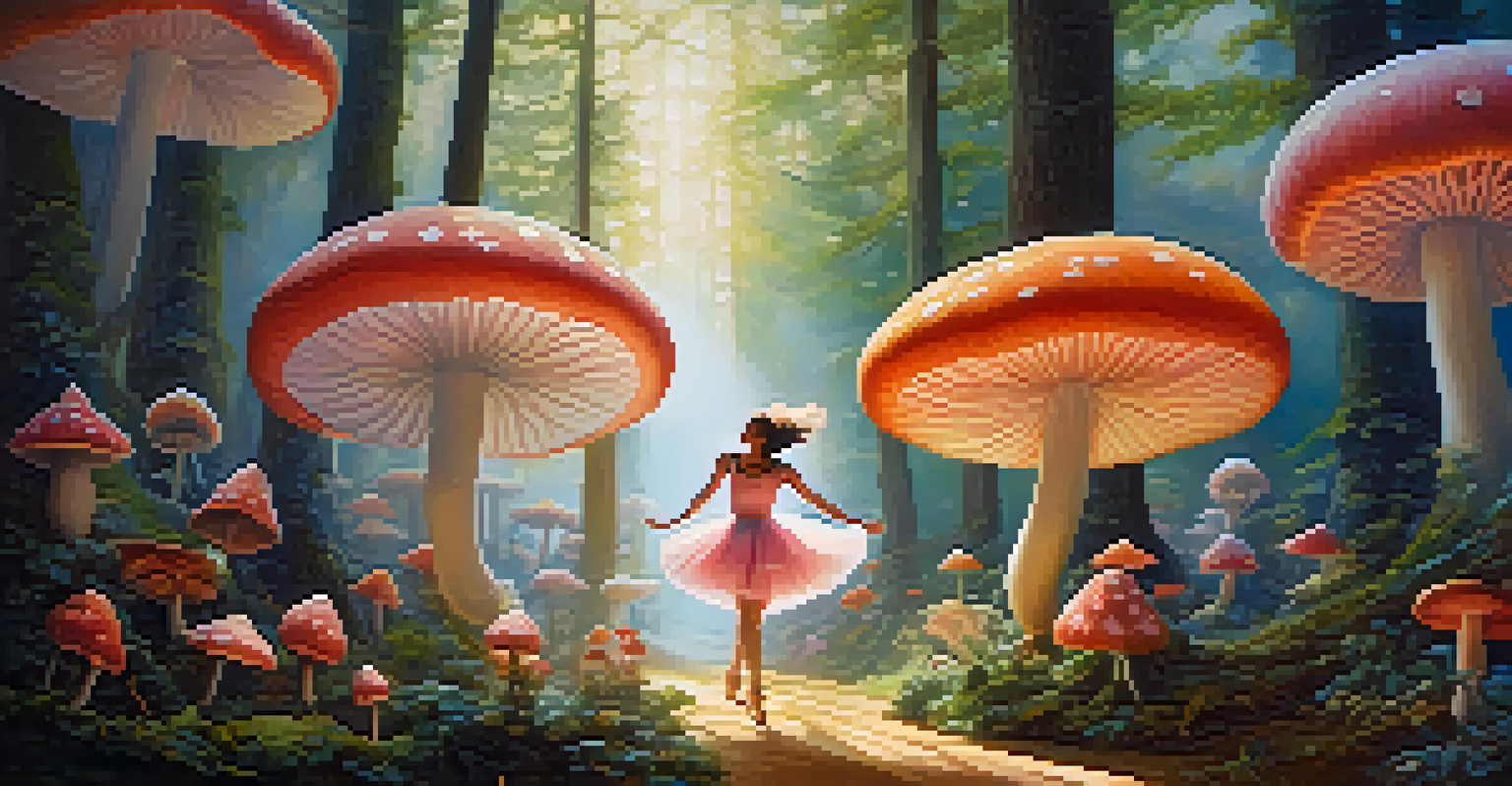Expressive Movements: How Dance Reflects Artistic Painting Styles

Understanding the Connection Between Dance and Art
Dance and painting may seem like two different worlds, but they share a deep connection. Both art forms express emotions and stories, often transcending words. Just as a painting captures a moment in time, dance encapsulates feelings through movement, creating a dialogue between the artist and the audience.
Dance is the hidden language of the soul.
When we observe a dancer, we might notice how their body movements mimic brush strokes or color palettes found in paintings. For example, the fluidity of a ballet performance can reflect the soft, sweeping lines of Impressionist art. This interplay invites viewers to see dance not just as a performance but as a living canvas.
Ultimately, both dance and painting serve the same purpose: to communicate and evoke emotions. By understanding this connection, we can appreciate how artists in both mediums influence and inspire each other.
The Influence of Impressionism on Dance Movement
Impressionism, with its emphasis on capturing light and movement, has significantly influenced dance. Dancers often embody the essence of Impressionist paintings, which depict fleeting moments and sensations. For instance, the way a dancer spins can evoke the swirling colors of a Monet landscape.

Choreographers draw inspiration from Impressionist techniques, focusing on a dancer's ability to convey emotion through subtle shifts in posture and movement. This approach encourages performers to explore the connection between their bodies and the environment, much like Impressionist artists who sought to portray nature's transient beauty.
Dance and Art Share Deep Connections
Both dance and painting express emotions and stories, creating a dialogue that transcends words.
Thus, the fluidity and expressiveness of Impressionism find a perfect home in dance, creating a symbiotic relationship that enriches both forms of artistic expression.
Expressionism: Raw Emotions in Dance
Expressionism, characterized by its focus on raw emotion and individual perspective, has a powerful impact on dance. Dancers often channel their own experiences, using movement to convey feelings of anguish, joy, or longing, much like Expressionist painters use bold colors and distorted forms. This connection allows for a visceral experience, where both the audience and the performers engage deeply with the art.
Art is the most beautiful of all lies.
In an Expressionist dance piece, the choreography may involve sharp, jagged movements that reflect the intense emotions being portrayed. Just as an artist might use dark hues to illustrate despair, a dancer may employ sudden, explosive actions to bring those feelings to life. This shared language of emotion creates a profound experience for spectators.
Through this lens, we can see how dance not only mirrors the emotional depth of Expressionist painting but also serves as a powerful medium for personal storytelling.
Futurism: Movement in Dance and Art
Futurism, an art movement that celebrates speed, technology, and modernity, has made its mark on dance as well. The dynamic and energetic movements found in Futurist paintings often translate into choreography that emphasizes rapid motion and the feeling of acceleration. Dancers can embody the essence of this movement, creating a sense of urgency that captivates the audience.
In Futurist-inspired performances, we might see dancers utilizing sharp angles and quick transitions, reflecting the artists' fascination with machinery and innovation. This approach not only energizes the performance but also invites the audience to experience the thrill of modern life, much like Futurist artists aimed to capture.
Art Movements Influence Dance Styles
Various art movements like Impressionism, Expressionism, and Surrealism significantly shape dance choreography and expression.
Thus, the relationship between dance and Futurism exemplifies how movement can embody the core principles of an art movement, offering a fresh perspective on both mediums.
Cubism: Breaking Down Movement and Form
Cubism, with its fragmented forms and multiple perspectives, provides a unique lens through which to view dance. In a Cubist-inspired dance piece, movements might be deconstructed and reassembled, creating a visual experience that mirrors the complexities of Cubist art. Dancers can explore various angles and dimensions, allowing audiences to perceive each movement from multiple viewpoints.
This approach challenges traditional notions of dance as linear and cohesive, encouraging performers to experiment with disjointed movements that reflect the fragmented nature of Cubism. Just as artists like Picasso broke down forms to reveal deeper truths, dancers can do the same through their physical expressions.
Ultimately, Cubism invites both dancers and audiences to engage in a dialogue about perception, challenging them to see beauty in the unconventional.
Surrealism: Dreamlike Movements in Dance
Surrealism, known for its dreamlike imagery and exploration of the subconscious, has a fascinating relationship with dance. Choreographers often draw inspiration from Surrealist principles, creating performances that evoke a sense of otherworldliness. Through unexpected movements and whimsical narratives, dancers can transport audiences into a dreamscape, much like Surrealist paintings do.
In a Surrealist dance, we might witness the blending of reality and fantasy, with performers engaging in unusual movements that defy logic. This unpredictability encourages audiences to let go of conventional expectations and embrace the imaginative possibilities of both art forms. The result is an experience that feels both enchanting and thought-provoking.
Dance as a Living Artistic Expression
Dance serves as a vibrant medium that reflects artistic styles, allowing audiences to experience a rich tapestry of creativity.
By exploring the surreal, dance becomes a medium for tapping into the subconscious, inviting viewers to interpret emotions and narratives in their own unique ways.
Conclusion: The Interplay of Dance and Artistic Styles
As we've explored, dance is more than just movement; it’s a vibrant expression of artistic styles that resonates across various forms of art. From the fluidity of Impressionism to the dreamlike quality of Surrealism, each movement tells a story that reflects the emotions and ideas of its time. By recognizing these connections, we can appreciate the rich tapestry of creativity that intertwines dance and painting.
Ultimately, both dance and art serve as powerful tools for expression, allowing individuals to convey their thoughts and feelings in unique ways. This interplay not only enhances our understanding of each medium but also enriches our experiences as audiences.

So the next time you watch a dance performance, take a moment to consider the artistic influences at play. You might just find yourself seeing the dance as a living piece of art, resonating with the strokes of a painter’s brush.